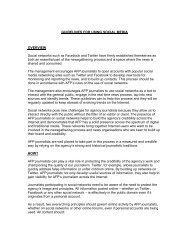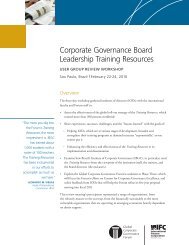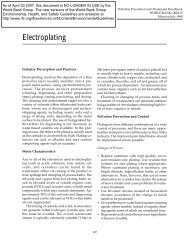SME Finance Policy Guide
SME Finance Policy Guide
SME Finance Policy Guide
Create successful ePaper yourself
Turn your PDF publications into a flip-book with our unique Google optimized e-Paper software.
78 GLOBAL PARTNERSHIP FOR FINANCIAL INCLUSION<br />
structure at the outset. The most effective apexes are<br />
those that are politically independent, with professional,<br />
effective boards and capable management.<br />
• Select the right institutions. Apexes need robust<br />
selection criteria and appraisal procedures and<br />
should focus not on the number of the financial institutions<br />
they fund, but rather the quality of those<br />
institutions.<br />
• Design the mission and instruments to fit with the<br />
market context. Apex loans should be tailored to the<br />
cash flow patterns and planning needs of financial<br />
institutions. In more mature markets, apexes might<br />
want to consider broadening their range of products<br />
to include quasi-equity, equity, or guarantees.<br />
• Manage an apex portfolio based on performance. To<br />
ensure good performance, apexes need to have good<br />
quality data on financial institution portfolios,<br />
review their progress on a regular basis, and be willing<br />
to act in the case of poor performance.<br />
• Provide adequate support for building the staff<br />
capacity of the apex itself. At an early stage of its<br />
development, funders of apexes (including governments)<br />
should ensure that the apex has the right<br />
team in place and is receiving technical support to<br />
build its own staff capacity.<br />
• Encourage apexes to crowd in commercial local<br />
funding by having this as one of their objectives.<br />
Funders of apexes, including governments, should<br />
encourage apexes to collaborate and share information<br />
with local banks and international commercial<br />
lenders. 92<br />
Partial Credit Guarantee Schemes<br />
Credit guarantee schemes are considered one of the<br />
more market-friendly types of interventions, as they<br />
can generate fewer distortions in the credit market<br />
than state banks and other direct public interventions,<br />
and may lead to better credit allocation. Key features of<br />
a well-designed scheme include:<br />
• Eligibility criteria: Guarantee schemes should target<br />
<strong>SME</strong>s through ceilings on turnover, number of<br />
employees, and/or size of the loan. Restrictions on<br />
sectors or types of loans should generally be<br />
avoided.<br />
• Approval rules and procedures: Final approval or rejection<br />
of an application should occur within two<br />
weeks.<br />
• Coverage ratios: Coverage ratios should ensure sufficient<br />
protection against default risk while maintaining<br />
strong incentives for effective loan origination<br />
and monitoring.<br />
• Fees: Fees should be risk-based and contribute to the<br />
financial sustainability of the scheme.<br />
• Payment rules and procedures: Payment rules should take<br />
into account the effectiveness of the collateral and<br />
insolvency regimes. Schemes in LDCs should base<br />
payments on default events while ensuring incentives<br />
for effective debt collection.<br />
• Capacity building: PCGs can support the capacity of<br />
banks to provide <strong>SME</strong> finance and good practices.<br />
• Evaluation mechanism: Such a mechanism is necessary to<br />
measure outreach, additionality, and sustainability.<br />
• Supervision: Oversight is a key element to ensuring the<br />
soundness of operations.<br />
• Risk weighting for banks’ prudential requirements: A well<br />
designed and financially robust guarantee scheme<br />
should allow regulators to assign a lower risk weight<br />
to exposures covered by the guarantee.<br />
Government Procurement from <strong>SME</strong>s<br />
The public sector can be a major buyer of goods and<br />
services from <strong>SME</strong>s, and can more effectively link<br />
<strong>SME</strong>s to supply chain finance and to factoring through<br />
that contractual and payment relationship. Electronic<br />
security and signature laws, and market facilitation<br />
platforms, can facilitate supply chain and factoring<br />
transactions with <strong>SME</strong>s.<br />
It is also critical that governments pay <strong>SME</strong>s promptly,<br />
in order to avoid otherwise viable <strong>SME</strong>s incurring cash<br />
flow problems that can cause them to scale back or<br />
even close business activity.<br />
92 Extracted from Forster, Sarah and Duflos, Eric – “Re-assessing the Role of Apexes: Findings and Lessons Learned”, Forthcoming, CGAP,<br />
2011.














![Print a two-page fact sheet on this project [PDF] - IFC](https://img.yumpu.com/43449799/1/190x245/print-a-two-page-fact-sheet-on-this-project-pdf-ifc.jpg?quality=85)


